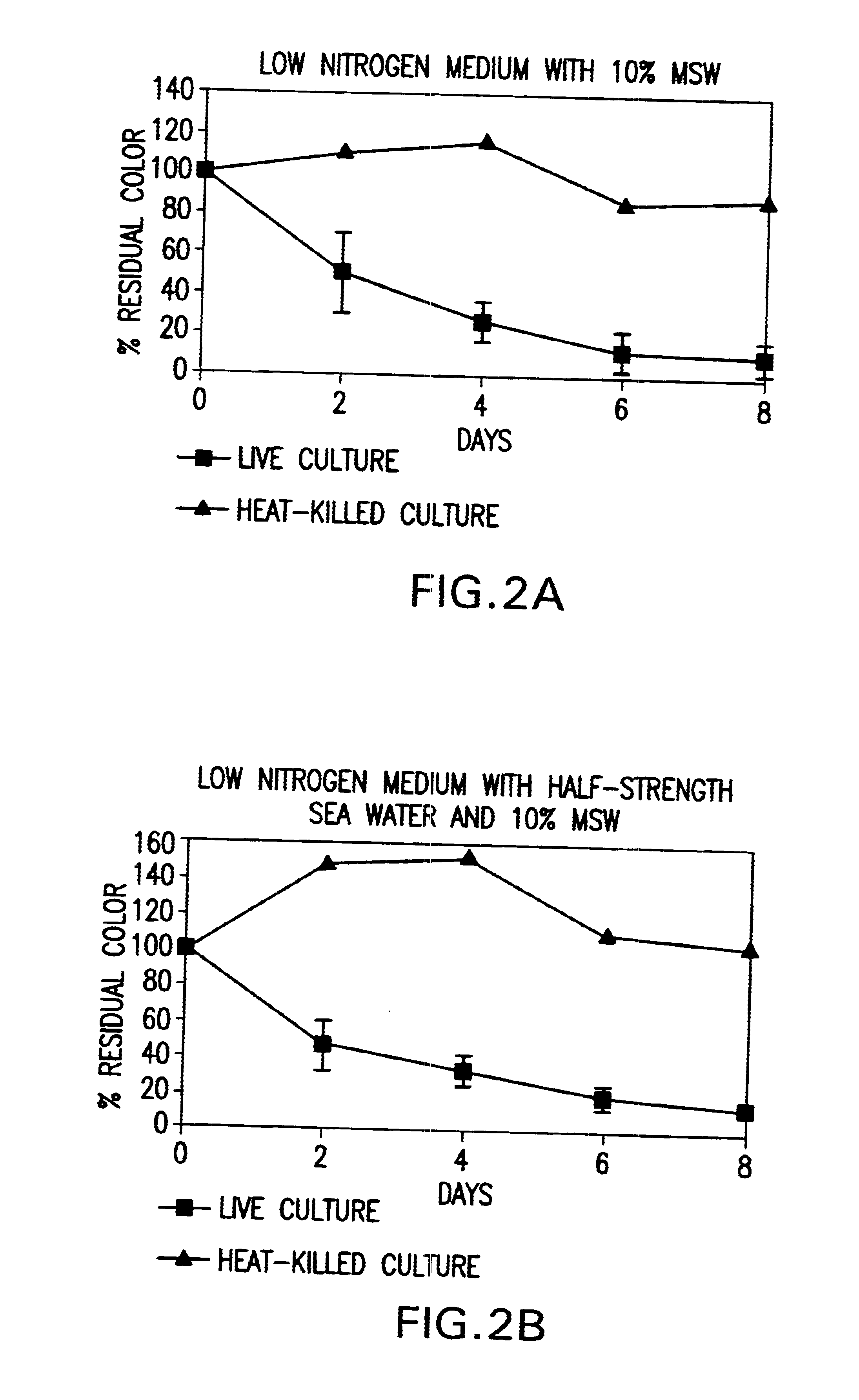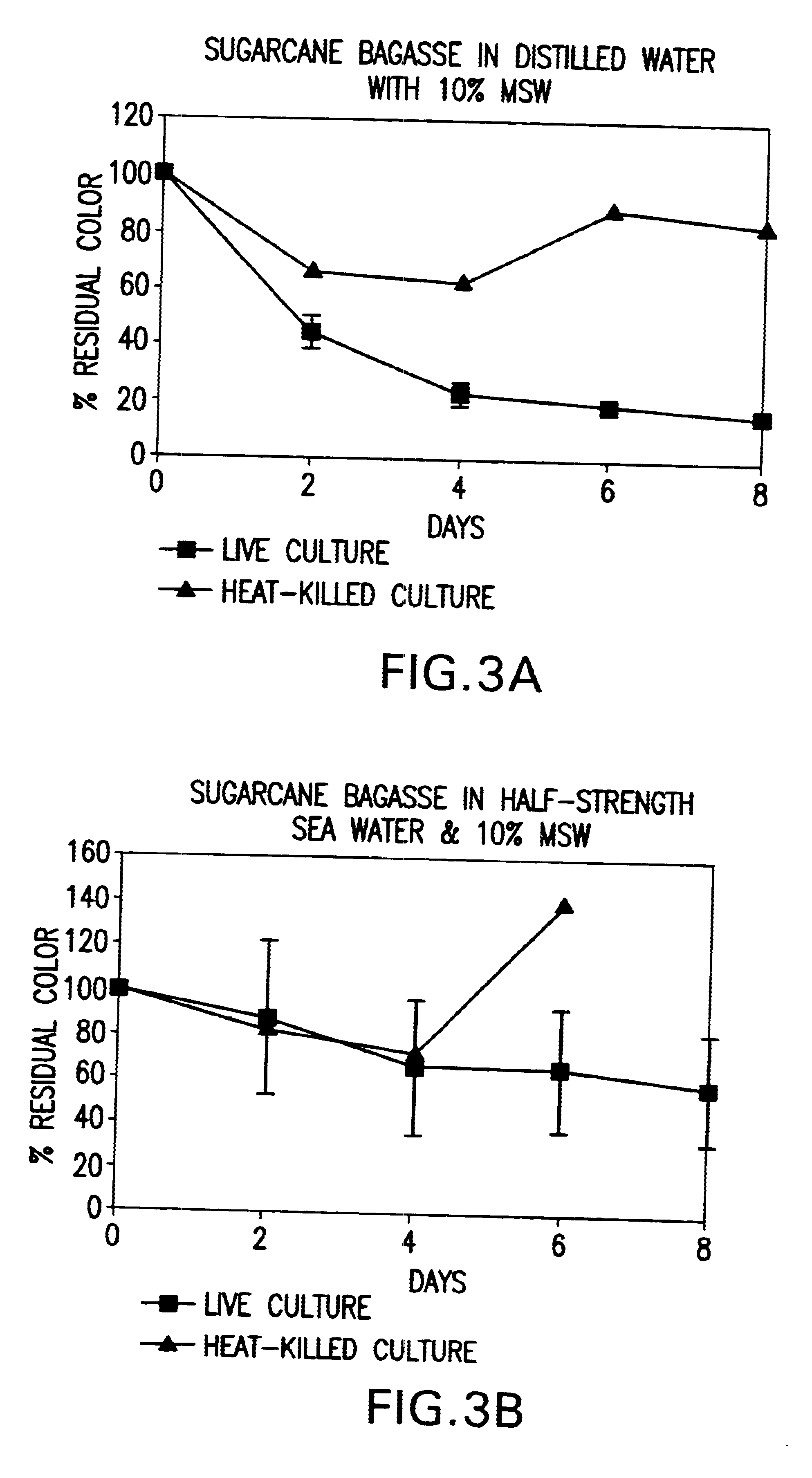Simultaneous decolorization and detoxification of molasses spent wash using novel white rot-lignin-modifying fungus Flavodon flavus
a technology fungus, which is applied in the nature of treatment water, biological water/sewage treatment, centrifuges, etc., can solve the problems of molasses spent wash being a major environmental hazard to land or aquatic sources, a large concentration of bod and cod, and aesthetic damage to sites, etc., to achieve broad substrate specificity and oxidize several environmental pollutants
- Summary
- Abstract
- Description
- Claims
- Application Information
AI Technical Summary
Benefits of technology
Problems solved by technology
Method used
Image
Examples
example 2
The ability of Flavodon flavus, which has been deposited at National Institute of Oceanography, Dona Paula, Goa, India, bearing the accession No. NIOCC #312 and also at ARS Patent Collection (NRRL), USDA, Illinois, U.S.A., bearing accession No. NRRL 30302, to decolorize molasses spent wash in nutrient rich medium such as malt extract broth (ME broth) was tested. ME broth contains 3% malt extract and 0.5% peptone in distilled water. To 9 ml of ME broth having 4 day old culture (raised as described above), 1 ml of sterilized MSW was added (final concentration of MSW being 10%) and the cultures were oxygenated for 1 min. Autoclaved cultures supplemented with MSW served as heat-killed controls. Aliquots (0.5 ml) of culture supernatants from experimental and heat-killed cultures were appropriately diluted and changes in absorbance maximum at 475 nm were measured using a Shimadzu UV-Visible spectrophotometer (Shimadzu, Japan). The results are calculated as the difference in percent decolo...
example 3
The ability of Flavodon flavus, which has been deposited at National Institute of Oceanography, Dona Paula, Goa, India, bearing the accession No. NIOCC #312 and also at ARS Patent Collection (NRRL), USDA, Illinois, U.S.A., bearing accession No. NRRL 30302 to decolorize molasses spent wash in synthetic medium such as low nitrogen medium prepared with distilled water and half-strength sea water containing 10% glucose as carbon source, 2.4 mM ammonium tartrate as the nitrogen source, thiamine, trace metal solution, macro element solution containing sodium, potassium and manganese salts, Tween 80, veratryl alcohol and 20 mM sodium acetate buffer at pH 4.5. To 9 ml of low nitrogen medium containing 4-day-old culture of F. flavus, 1 ml of sterilized raw MSW (final concentration of MSW being 10%) was added and the cultures were treated and absorbance taken as described in the Example 2.
Accordingly, FIGS. 2a and 2b show percentage of residual color in the medium prepared with distilled wate...
example 4
The ability of Flavodon flavus, which has been deposited at National Institute of Oceanography, Dona Paula, Goa, India, bearing the accession No. NIOCC #312 and also at ARS Patent Collection (NRRL), USDA, Illinois, U.S.A., bearing accession No. NRRL 30302 to decolorize molasses spent wash in inexpensive simple substrate such as sugarcane bagasse was tested. Powdered sugarcane bagasse (1% weight / volume) was suspended in distilled water or half-strength seawater. To 4 day old culture of F. flavus growing in these media, MSW to the final concentration of 10% as described above was added and decolorization monitored as described previously in the Example 2.
Accordingly, FIGS. 3a and 3b show percentage residual color in the medium prepared with distilled water and half-strength seawater using live and heat-killed cultures. By the day 8, about 80% and 50% decolorization was observed in distilled water and half-strength seawater respectively. By day 2, 50% and 20% decolorization was achieve...
PUM
| Property | Measurement | Unit |
|---|---|---|
| salinity | aaaaa | aaaaa |
| concentration | aaaaa | aaaaa |
| chemical oxygen demand | aaaaa | aaaaa |
Abstract
Description
Claims
Application Information
 Login to View More
Login to View More - R&D
- Intellectual Property
- Life Sciences
- Materials
- Tech Scout
- Unparalleled Data Quality
- Higher Quality Content
- 60% Fewer Hallucinations
Browse by: Latest US Patents, China's latest patents, Technical Efficacy Thesaurus, Application Domain, Technology Topic, Popular Technical Reports.
© 2025 PatSnap. All rights reserved.Legal|Privacy policy|Modern Slavery Act Transparency Statement|Sitemap|About US| Contact US: help@patsnap.com



